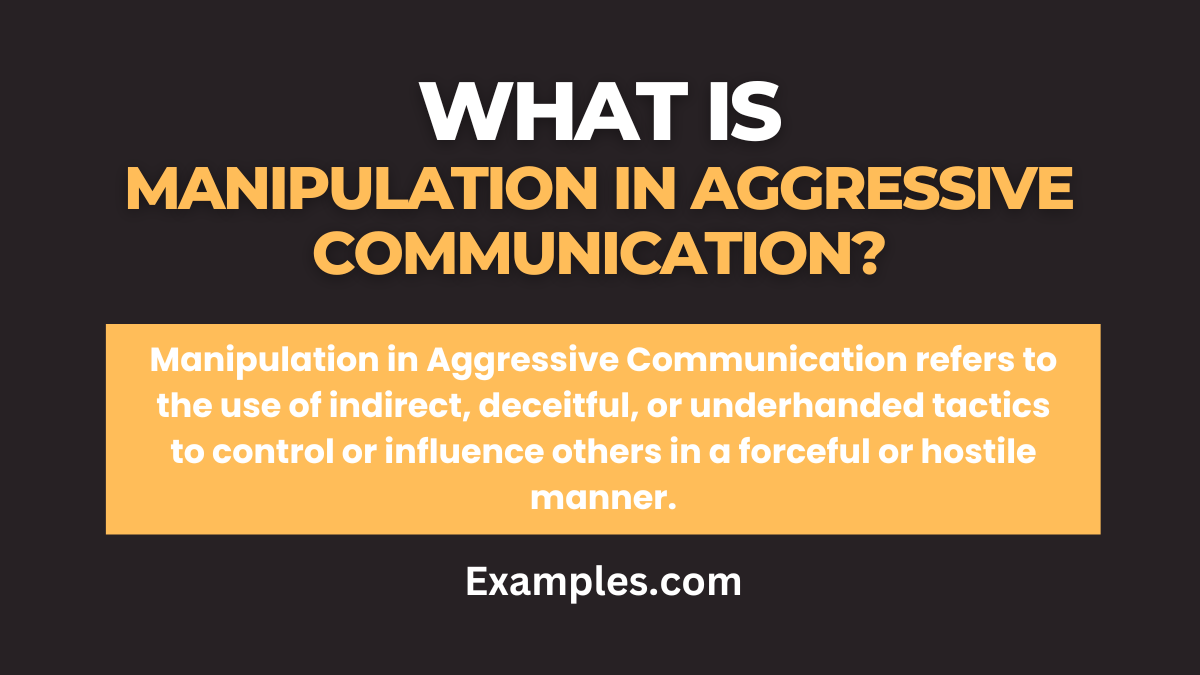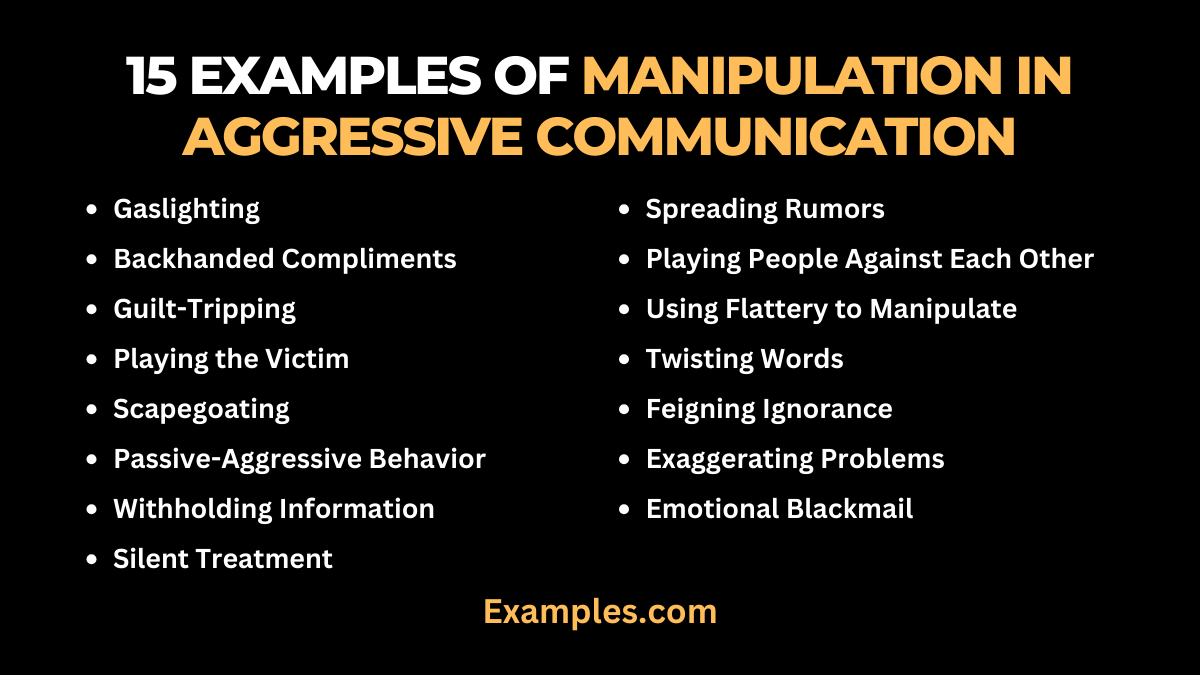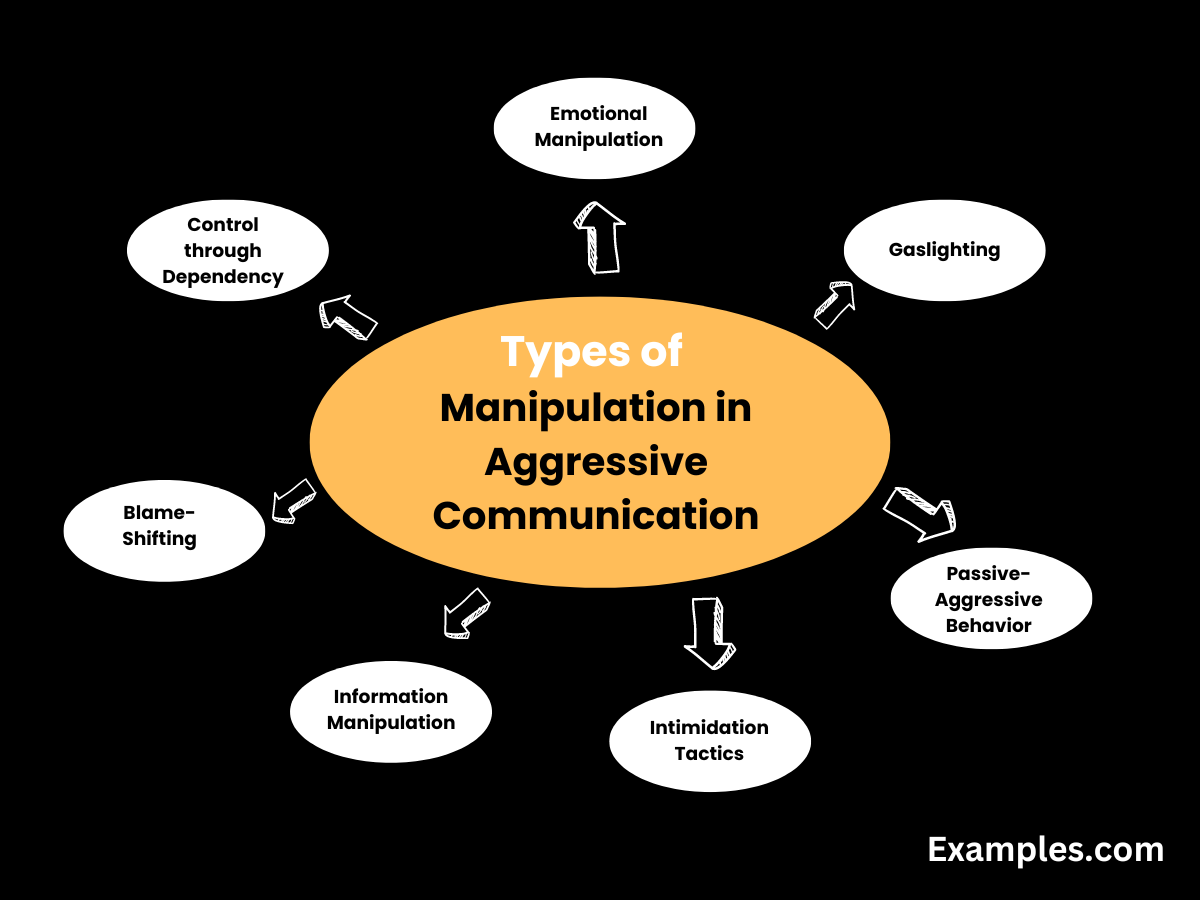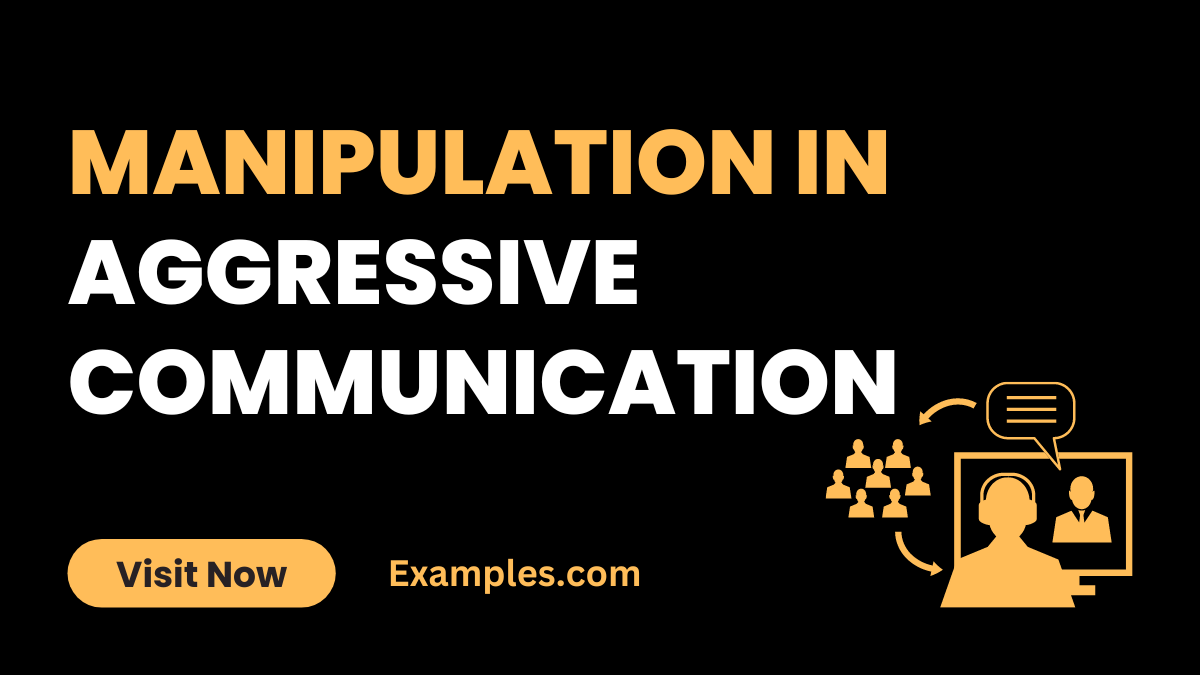14+ Manipulation in Aggressive Communication Examples
Dive into the intricacies of Manipulation in Aggressive Communication with this detailed guide. Filled with insightful Aggressive Communication Examples, it sheds light on various manipulative tactics often employed in aggressive interactions. Whether you’re dealing with manipulation in the workplace, personal relationships, or broader social contexts, this guide offers a deep understanding of how manipulation works and practical advice on how to respond effectively. Learn to identify, understand, and navigate these complex communication challenges with clarity and confidence.
What is Manipulation in Aggressive Communication?

Manipulation in Aggressive Communication refers to the use of indirect, deceitful, or underhanded tactics to control or influence others in a forceful or hostile manner. This type of communication often involves exploiting power imbalances, using guilt, coercion, or misinformation to achieve a desired outcome. It’s a way of communicating where one person tries to assert dominance by manipulating the emotions or perceptions of another, often leading to unhealthy and unproductive interactions.
15 Examples of Manipulation in Aggressive Communication
Manipulation in aggressive communication encompasses a range of tactics used to control or influence others through indirect, deceitful, or unfair means. This guide highlights 15 distinct examples of manipulative behaviors often encountered in aggressive communication scenarios. Understanding these tactics is crucial for recognizing and addressing manipulation, whether in personal relationships, the workplace, or other social interactions. Each example is elaborated with a specific communication scenario, providing clarity on how these manipulative tactics play out in real life.

- Gaslighting: Making someone question their reality or memories.
Example: “You’re remembering it wrong; that’s not how it happened at all.” - Backhanded Compliments: Disguising criticism with a compliment.
Example: “It’s impressive how you finally managed to do something right.” - Guilt-Tripping: Making someone feel guilty to get them to comply.
Example: “If you really cared about me, you wouldn’t hesitate to do this.” - Playing the Victim: Portraying oneself as a victim to deflect blame.
Example: “You’re accusing me, but I’m the one who always gets hurt here.” - Scapegoating: Blaming others for one’s own mistakes.
Example: “This project failed because of your incompetence, not my leadership.” - Passive-Aggressive Behavior: Expressing negative feelings indirectly.
Example: “I’m fine,” while clearly demonstrating hostile behavior. - Withholding Information: Deliberately keeping information to gain an advantage.
Example: “I thought you knew, I didn’t think I needed to tell you.” - Silent Treatment: Refusing to communicate to exert control.
Example: Ignoring someone’s attempts at conversation as a form of punishment. - Spreading Rumors: Creating and spreading false information about someone.
Example: “I heard from others that you’re not to be trusted.” - Playing People Against Each Other: Pitting individuals against each other to maintain control.
Example: “You know, your colleague doesn’t think highly of you.” - Using Flattery to Manipulate: Giving excessive, insincere praise to sway someone.
Example: “Only someone as smart as you could understand why this is a good idea.” - Twisting Words: Misrepresenting someone’s words to one’s advantage.
Example: “What I’m hearing is that you don’t value our team’s effort.” - Feigning Ignorance: Pretending not to understand to avoid responsibility.
Example: “I had no idea that’s what you meant; you should have been clearer.” - Exaggerating Problems: Blowing issues out of proportion to manipulate.
Example: “If this doesn’t get done, it will be a complete disaster for everyone.” - Emotional Blackmail: Using emotions to pressure someone.
Example: “If you leave now, it shows you don’t care about what we have.”
Types of Manipulation in Aggressive Communication
In the context of Aggressive Communication, manipulation can take various forms, each with its unique challenges. Understanding these types is crucial for recognizing and effectively responding to manipulative tactics.

Emotional Manipulation: This involves using emotional triggers to influence someone’s actions or decisions. It often includes guilt-tripping, playing the victim, or exploiting someone’s empathy or fears.
Gaslighting: A manipulator uses gaslighting to make someone question their own reality, memory, or perceptions. It’s a form of psychological manipulation that creates doubt in an individual’s mind.
Passive-Aggressive Behavior: This is expressing aggression in indirect ways. It can include backhanded compliments, the silent treatment, or subtle sabotage, which indirectly communicate hostility.
Intimidation Tactics: Using threats or fear-inducing tactics to force compliance. This form of manipulation is often overt and can include verbal threats or aggressive body language.
Information Manipulation: This includes withholding, distorting, or misrepresenting information to mislead or control someone’s perception or decision-making process.
Blame-Shifting: Redirecting responsibility for one’s actions to others. Blame-shifters often avoid accountability by making others feel guilty or responsible for their mistakes.
Control through Dependency: Creating a sense of dependency by making someone feel they cannot function or make decisions without the manipulator’s help or approval.
Addressing the Challenges of Manipulative Tactics in Aggressive Communication
Navigating manipulative tactics in Aggressive Communication is challenging but essential for maintaining healthy interpersonal relationships and professional environments.
Develop Awareness and Recognition: The first step in addressing manipulation is to recognize its occurrence. Being aware of the various tactics used can help in identifying manipulation early.
Set Clear Boundaries: Establish and communicate your boundaries clearly. Let the manipulator know what behavior is unacceptable and stick to these boundaries firmly.
Maintain Emotional Control: Manipulators often target emotional vulnerabilities. Staying calm and not reacting emotionally can reduce their power in the situation.
Seek External Perspective: Sometimes, it’s challenging to see manipulation when you are directly involved. Seeking advice or perspective from a trusted person can provide clarity.
Improve Communication Skills: Developing assertive communication skills helps in expressing your needs and opinions clearly without being aggressive or submissive.
Empower Yourself with Information: Being well-informed reduces the chances of being misled. If you suspect information manipulation, seek out accurate and reliable sources.
How do Manipulative Tactics Manifest in Aggressive Communication?
In the sphere of Aggressive Communication, manipulative tactics are often subtly interwoven into interactions, making them challenging to recognize. Understanding how these tactics manifest is crucial for identifying and addressing them effectively.
Use of Coercive Language: Manipulators often use coercive language to exert control or influence. This can include demanding language, ultimatums, or threats, subtly or overtly pressuring the recipient to comply.
Playing the Victim: A common tactic is portraying oneself as a victim to gain sympathy or justify unreasonable demands. This tactic manipulates the recipient’s empathy to achieve the aggressor’s goals.
Gaslighting: Gaslighting involves questioning the recipient’s memory or perception of events, making them doubt their own experiences. It’s a psychological tactic used to gain power over the recipient.
Withholding Information: Manipulators may withhold or selectively share information to skew the recipient’s understanding of a situation, leading to decisions that favor the manipulator.
Guilt-Tripping: This involves making someone feel guilty to manipulate their actions or decisions. It’s a tactic that exploits the recipient’s sense of obligation or responsibility.
Backhanded Compliments: These are compliments with a hidden insult or criticism, used to undermine the recipient’s confidence while appearing to praise them.
Passive-Aggressive Comments: Indirectly expressing aggression through sarcasm, veiled comments, or non-verbal cues is a hallmark of passive-aggressive manipulation.
What are the Common Signs of Manipulation within an Aggressive Conversation?
Identifying signs of manipulation within an aggressive conversation is key to safeguarding oneself from the negative impacts of such interactions. Recognizing these signs can help in taking steps to address the manipulation.
Unwarranted Blame or Accusations: Manipulators often use blame or accusations to divert attention from their actions or to gain control in a conversation.
Consistent Interruption and Over-Talking: Interrupting or speaking over someone consistently can be a tactic to dominate the conversation and suppress the other person’s perspective.
Rapid Subject Changes: Frequent and abrupt changes in conversation topics can be a tactic to confuse or throw the other person off balance.
Disproportionate Emotional Responses: Exaggerated emotional reactions, such as anger or distress, can be used to manipulate the recipient into compliance or silence.
Inconsistencies in Statements: Manipulators might display inconsistencies or contradictions in their statements, often to confuse or deceive the other person.
Belittling or Dismissal: Dismissive comments or belittling the recipient’s thoughts and feelings are tactics used to undermine their confidence and assert dominance.



